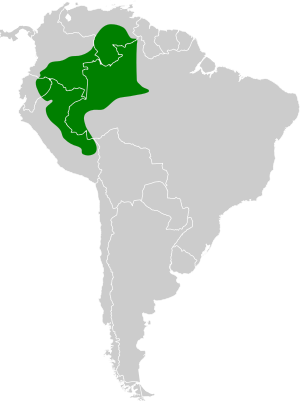Rufous-backed stipplethroat facts for kids
Quick facts for kids Stipple-throated antwren |
|
|---|---|
| Conservation status | |
| Scientific classification | |
| Genus: |
Epinecrophylla
|
| Species: |
haematonota
|
 |
|
The rufous-backed stipplethroat is a small bird found in the warm, wet forests of South America. It's also known as the rufous-backed antwren or the stipple-throated antwren. This bird belongs to a family called Thamnophilidae, which includes many antbirds. You can find it in countries like Colombia, Venezuela, Ecuador, Peru, and Brazil. It prefers to live in moist lowland forests where the weather is subtropical or tropical.
Contents
About the Rufous-backed Stipplethroat
How Scientists Name Birds
The rufous-backed stipplethroat was first described by an English zoologist named Philip Sclater in 1857. He gave it the scientific name Formicivora haematonota. Later, scientists decided to move it to a different group, or genus, called Myrmotherula.
In 2014, its scientific name changed again. This happened when some birds that were once thought to be the same species were separated. These were the Negro stipple-throated antwren and the Yasuni antwren. However, scientists later found that their calls sounded the same. Also, their physical differences were very small. Because of this, they were put back together as different types, or subspecies, of the rufous-backed stipplethroat.
What Does This Bird Look Like?
The rufous-backed stipplethroat is a small bird, usually about 11 cm (4.3 in) long. That's about the length of a pen!
The male bird has mostly brown feathers on its upper body. Its back and rump (the area above its tail) are a reddish-brown color. Its wing feathers are black with white spots and two white bars. The male's throat is black with white spots, making it look "stippled." The sides of its head, chest, and belly are grey.
The female bird looks a lot like the male. However, her wing feathers have buff (a pale yellowish-brown) tips. The sides of her face and her throat are a yellowish-orange color, sometimes with a touch of red.
Both male and female birds have brown tails. This helps tell them apart from a similar bird, the rufous-tailed stipplethroat (Epinecrophylla erythrura), which has a reddish tail. The color of their eyes can be orange, dark, or whitish.
When the rufous-backed stipplethroat sings, it makes a trilling sound. These are short, quick notes that first go higher in pitch and then get lower.
What Do They Eat and Where Do They Live?
These birds are often seen flying through the forest in small groups. They sometimes join other types of small birds. They look for food in the lower parts of the tree canopy, which is the upper layer of branches and leaves.
Their diet is mainly made up of insects and spiders. They especially like crickets. They search for food on fresh shoots and leaves. They also like to poke around in curled, dead leaves, where insects might be hiding.
Conservation Status
The Epinecrophylla haematonota is a fairly common bird. It lives across a wide area of South America. Scientists do not know of any major threats to this bird right now. Because of this, its population is thought to be stable. The International Union for Conservation of Nature (IUCN) has given this bird a conservation status of "least concern". This means it is not currently at risk of disappearing.
See also
 In Spanish: Hormiguerito dorsirrojo para niños
In Spanish: Hormiguerito dorsirrojo para niños


